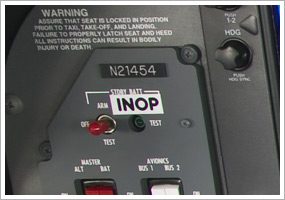| The following stories from the July 22, 2011, edition of AOPA ePilot were provided to AOPA members who expressed an interest in the particular subject areas. Any AOPA member can receive information tailored to their areas of interest by updating their preferences online. |
training tipsPlacards
A placard might be in place near the fuel selector valve to show you how to select the desired fuel tank, and remind you how much gas the aircraft holds. Another placard near the fuel tank filler cap is there to remind you of the proper grade of fuel to use.
A placard on the instrument panel might be in place to provide a short checklist of steps to follow in the event, say, of a spin recovery. In some Cessna 172s, you may see a placard stating limitations on performing a slip with flaps extended.
A placard near the airspeed indicator may tell you the aircraft’s maneuvering speed; you may see others that state the oil quantity, or the need to remove a control lock before starting the engine.
Can you name a placard that may only appear temporarily in the aircraft?
FAR 91.213 states that in some cases, inoperative equipment may be placarded, allowing the aircraft to be flown. That sounds straightforward, but depending on what is broken, it can get complicated, as Kathy Yodice detailed in the March 2004 Flight Training magazine’s Legal Briefing column. She also reminds pilots that “at the next required inspection of the aircraft, the inoperative instrument or piece of equipment must be repaired, replaced, removed, or inspected. At that time, if the item is to remain inoperative, only a mechanic may authorize the continued required placarding and must make the appropriate maintenance entry. The pilot's responsibility is to ensure that the mechanic does this before further flights in the airplane are made.”
Does your aircraft operate under an approved minimum equipment list? If so, the rule contains different provisions that you should be able to explain.
Rod Machado had this advice for a pilot facing the dilemma of a nonfunctioning landing light. (He also volunteered some thoughts on the logistical challenges of manufacturing a makeshift placard in the field.)
Placards are also one of the sources of the operating limitations a pilot must know about his or her aircraft, so make sure that they are all in place (and legible) when you fly. training productsHold Here appProfessional pilot and aviation blogger Pat Flannigan has created Hold Here, an app designed to help pilots figure out which type of holding pattern over a given fix would be recommended by the Federal Aviation Regulations/Aeronautical Information Manual. The app also calculates how long an aircraft can hold at a fix before it reaches the point at which it must fly to the destination and then to the alternate without burning its 45-minute fuel reserve. The app sells for $1.99 and may be ordered from iTunes.
Note: Products listed have not been evaluated by ePilot editors unless otherwise noted. AOPA assumes no responsibility for products or services listed or for claims or actions by manufacturers or vendors. final exam
Question: Is an ELT (emergency locator transmitter) required on all aircraft?
Answer: In most circumstances, yes, an ELT is required. There are numerous exceptions, however. The regulation addressing the question can be found in FAR 91.207. It states that no one may operate a U.S.-registered civil airplane unless an approved ELT that is in operable condition is attached, with some exceptions. Some of the exceptions can be found in paragraphs (e) and (f). Many pilots would be surprised to know that an ELT is not required on aircraft engaged in flight training as long as the operations remain within a 50-nautical-mile radius of the home airport. An aircraft also can be flown for up to 90 days without an ELT that has been temporarily removed for “inspection, repair, modification, or replacement.” In that case a placard showing that no ELT is installed must be placed in view of the pilot. A note also must be made in the aircraft logs addressing the removal. Check out AOPA’s subject report for more on ELTs.
Got a question for our technical services staff? E-mail [email protected] or call the Pilot Information Center, 800/872-2672. Don’t forget the online archive of “Final Exam” questions and answers, searchable by keyword or topic. |
 There sure are a lot of reminders in the cockpit of a general aviation trainer—and you’ll find even more of them on the fuselage or out on the wing.
There sure are a lot of reminders in the cockpit of a general aviation trainer—and you’ll find even more of them on the fuselage or out on the wing.

